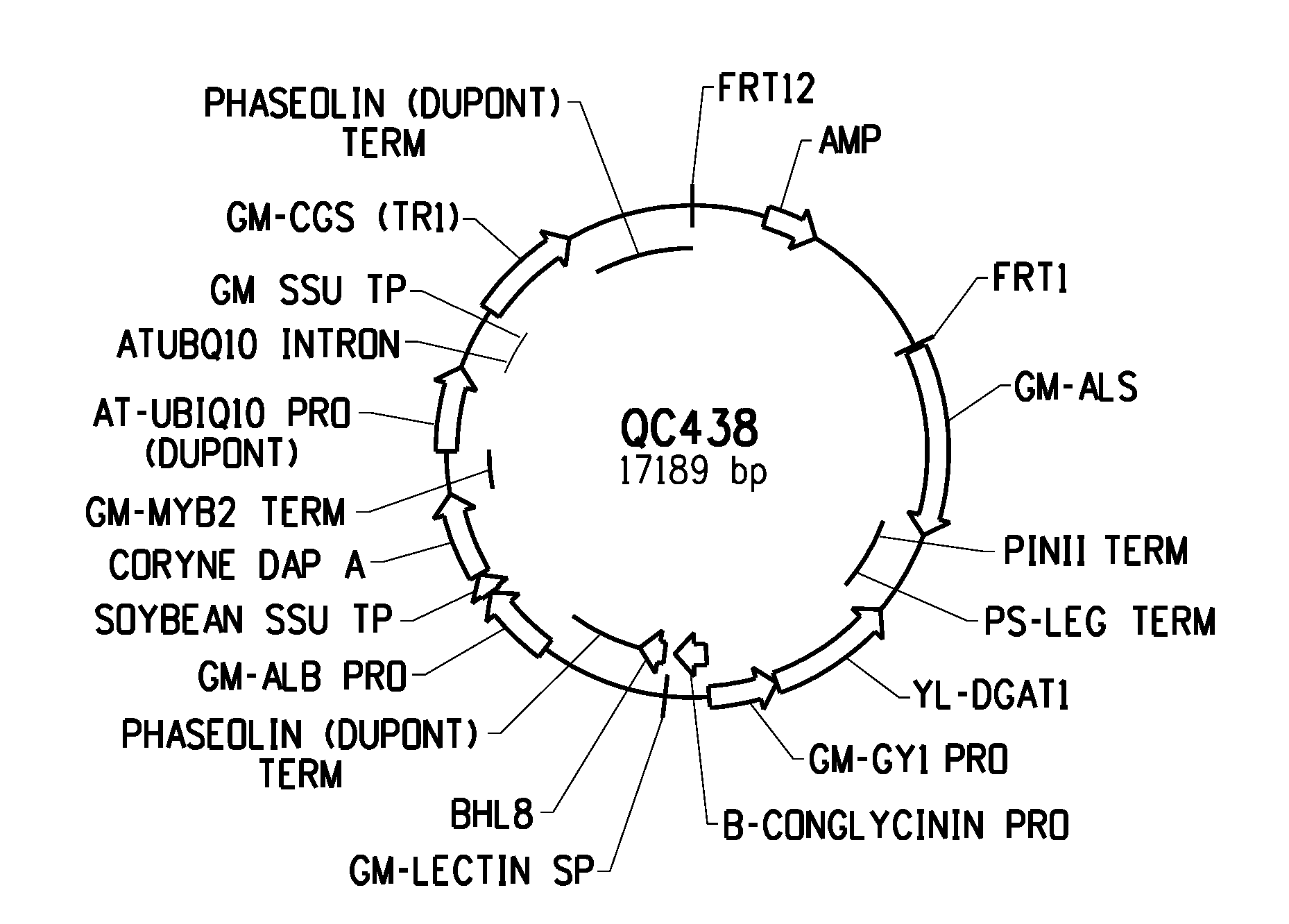Site-specific integration and stacking of transgenes in soybean via DNA recombinase mediated cassette exchange
a cassette exchange and site-specific technology, applied in the field of plant molecular biology, can solve the problems of multiple transgene copies, unpredicted integration sites, unpredictable integration sites, etc., and achieve the effect of avoiding the loss of genomic sites
- Summary
- Abstract
- Description
- Claims
- Application Information
AI Technical Summary
Problems solved by technology
Method used
Image
Examples
example 1
FLP / FRT Mediated RMCE Experimental Design and DNA Construction
[0247]The target QC288A and donor QC329 constructs were designed each containing a FRT1 site (solid triangle) and a FRT87 site (open triangle) in the same orientation (FIG. 1A, FIG. 2A, FIG. 1B, FIG. 2B). FRT1 is the wild-type recombination site for FLP recombinase and FRT87 is a modified recombination site (PCT Publication No. WO2007011733 published on Jan. 25, 2007). The circular QC329 DNA could integrate into the linear QC288A DNA previously placed in soybean genome by FLP recombinase mediated DNA recombination at either the FRT1 site or the FRT87 site to form collinear intermediates that contained two FRT1 sites and two FRT87 sites. FLP recombinase mediated excision could occur to excise the intervening fragment either between the two FRT1 sites or between the FRT87 sites. The net result of the integration via recombination between one identical pair of FRT sites and subsequent excision via recombination between the o...
example 2
Target Event Creation and Characterization
[0252]The scp1-FRT1:hpt:nos+ubiq10:yfp:nos-FRT87 cassette of QC288 was released as a 4544 by DNA fragment QC288A with AscI digestion, resolved by agarose gel electrophoresis, and purified using a Qiagen gel extraction kit (Qiagen, Valencia, Calif., USA). Soybean embryogenic suspension cultures were transformed with QC288A DNA following the biolistic bombardment transformation protocol using 30 μg / ml hygromycin for transgenic events selection (Li et al, (2007) Plant Mol. Biol. 65:329-341; Klein et al. (1987) Nature 327:70-73; U.S. Pat. No. 4,945,050)).
[0253]Soybean somatic embryos from the Jack cultivar were induced as follows. Cotyledons (smaller than 3 mm in length) were dissected from surface-sterilized, immature seeds and were cultured for 6-10 weeks under fluorescent light at 26° C. on a Murashige and Skoog media (“MS media”) containing 0.7% agar and supplemented with 10 mg / ml 2,4-dichlorophenoxyacetic acid (2,4-D). Globular stage somati...
example 3
Retransformation Event Creation and Characterization by PCR
[0263]Four transgenic events containing a single complete copy of the target QC288A DNA were maintained as suspension cultures and retransformed with the donor construct QC329 and the FLP construct QC292 at 10:1 ratio following the same biolistic bombardment transformation protocol described in EXAMPLE 2 except that retransformation events were selected using 90 ng / ml chlorsulfuron (DuPont, Wilmington, Del., USA). RMCE would only occur in cells containing all three DNA QC288A, QC329, and QC292 and would bring the promoter-less als coding region of QC329 downstream of the scp1 promoter of QC288A previously placed in soybean genome for expression and thus chlorsulfuron resistance.
[0264]The somatic embryo samples of putative retransformation events were screened by PCR as described in EXAMPLE 2 using construct-specific primers as depicted in FIGS. 1A-1E. Plasmid DNA of constructs QC288, QC329, QC292 were included as positive co...
PUM
| Property | Measurement | Unit |
|---|---|---|
| Time | aaaaa | aaaaa |
| Angle | aaaaa | aaaaa |
| Gene expression profile | aaaaa | aaaaa |
Abstract
Description
Claims
Application Information
 Login to View More
Login to View More - R&D
- Intellectual Property
- Life Sciences
- Materials
- Tech Scout
- Unparalleled Data Quality
- Higher Quality Content
- 60% Fewer Hallucinations
Browse by: Latest US Patents, China's latest patents, Technical Efficacy Thesaurus, Application Domain, Technology Topic, Popular Technical Reports.
© 2025 PatSnap. All rights reserved.Legal|Privacy policy|Modern Slavery Act Transparency Statement|Sitemap|About US| Contact US: help@patsnap.com



